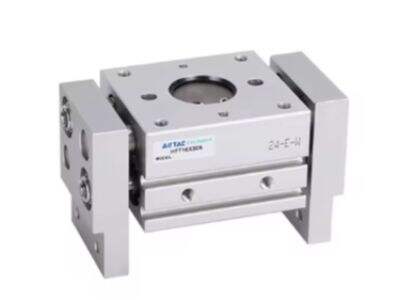Έχεις κάποτε σκεφτεί τι κάνουν μερικές από τις πιο εργατικές μηχανές σε μεγάλα βιομηχανικά κτίρια; Είναι πραγματικά ενδιαφέρον. Οι πνευματικοί ενεργοποιητές, οι οποίοι είναι κλειδιαίος συστατικός αυτών των μηχανών. Τι είναι πνευματικοί ενεργοποιητές - μπορείς να τους πεις ότι είναι όπως τα μύεστες στα σώματά μας. Παρόμοια με τα μύεστες και τον τρόπο που μας βοηθούν να κινούμαστε και να εκτελούμε εργασίες, οι πνευματικοί ενεργοποιητές βοηθούν τις μηχανές να κινούνται γρήγορα και να εκτελούν τις λειτουργίες τους αποτελεσματικά. Αυτός ο κείμενος θα σου διδάξει για τους πνευματικούς ενεργοποιητές, τον ρόλο τους στις βιομηχανικές διαδικασίες, πώς βοηθούν τις μηχανές να λειτουργούν αποτελεσματικά, και 5 συνηθισμένες εφαρμογές που τις βρίσκουμε κάθε μέρα.
5 Εφαρμογές Πνευματικών Ενεργοποιητών σε Βιομηχανίες
Υπάρχουν διαφορετικές μηχανές που χρησιμοποιούμε κάθε μέρα που έχουν πνευματικούς ενεργοποιητές σε αυτές. Για παράδειγμα, επιτρέπουν στα αυτοκίνητα να διαχειρίζονται κρίσιμα συστατικά όπως τα φρένα και τις πόρτες. Επίσης βοηθούν στην κίνηση των πτερυγίων στις αεροσκάφη και της οπωσιακής έξισώς σημαντικής εξοπλισμού που υποστηρίζει ασφαλής κατάβαση. Παράλληλα, οι πνευματικοί ενεργοποιητές χρησιμοποιούνται σε ρομπότ για να τα κάνουν να λειτουργούν με μεγάλη ευρυθμία. Σε φακτορεία, αυτοί οι ενεργοποιητές εκτελούν πολλές λειτουργίες όπως την εγγελία βαριών αντικειμένων, την ενεργοποίηση μηχανικών συστατικών και επίσης χρησιμοποιούνται για να ελέγχουν την κίνηση υγρών που χρησιμοποιούνται σε συγκεκριμένες εφαρμογές.
Χρήση Πνευματικών Ενεργοποιητών Για Γρήγορες Μηχανές
Για αυτόν τον λόγο, οι πνευματικοί ενεργοποιητές έχουν γίνει η αποφασιστική πηγή για φακτορίες, γρήγορη και αξιόπιστη. Ο ενεργοποιητής μπορεί να βάλει σε κίνηση πολύ γρήγορα όταν μια μηχανή πρέπει να κινηθεί. Η ταχύτητα είναι σημαντική, καθώς βοηθά τις φακτορίες να αποστέλλουν αυξημένη παραγωγή σε λιγότερο χρόνο. Χρησιμοποιείται συμπιεσμένο αέρας για την λειτουργία των πνευματικών ενεργοποιητών. Ο συμπιεσμένος αέρας είναι αέρας που εισάγεται σε μικρότερο χώρο και είναι πολύ δυνατός. Οι ενεργοποιητές μπορούν να φέρουν πολλά φορτία και λειτουργούν σε ακραίες συνθήκες με κακές συνθήκες.
5 Τυπικές Εφαρμογές Πνευματικών Ενεργοποιητών
Γραμμές συναρμολόγησης – Οι πνευματικοί ενεργοποιητές βοηθούν τους εργάτες στις φακτορίες να μετακινούν και να τοποθετούν διάφορα τμήματα με ακρίβεια και με πολύ υψηλή ταχύτητα. Αυτοί οι ενεργοποιητές βοηθούν στην γρήγορη μετακίνηση των συστατικών στη σωστή θέση τους, επιταχύνοντας σημαντικά την διαδικασία συναρμολόγησης. Αυτό το μέρος είναι σημαντικό γιατί βοηθά τη φακτορεία να παράγει περισσότερα άρθρα αποτελεσματικά.
Δοκιμή επεξεργαστή σώματος πληροφόρησης: ο επεξεργαστής σώματος πληροφόρησης είναι άλλος κρίσιμος υποσυστιματικός που χρησιμοποιείται μέσα σε μηχανισμούς πακετοποίησης με πνευματικούς επεξεργαστές. Βοηθούν στην διαταραχή υγρών, την σφράγιση των πακέτων αποδοτικά και την επισήμανση προϊόντων. Οι επεξεργαστές επιτρέπουν γρήγορη και ακριβή κίνηση των υλικών πακετοποίησης, που επιτρέπει ταχύτερη συνολική λειτουργία της μηχανής και μεγαλύτερη παραγωγή προϊόντων. Είναι σημαντικό για την κάλυψη της ζήτησης.
Ρομπότ – Οι πνευματικοί επεξεργαστές περιλαμβάνονται επίσης σε ρομπότ που χρησιμοποιούνται σε διάφορους τομείς. Χρησιμοποιούνται για να βοηθήσουν τα ρομπότ στην κίνηση και να εκτελούν διαδικασίες όπως η ανάληψη μερών, η συρμοποίηση μετάλλων και ακόμη και η διασπάση αυτοκινήτων. Οι πνευματικοί επεξεργαστές έχουν υψηλή ακρίβεια και γρήγορη απάντηση, που κάνει τη λειτουργία των ρομπότ στις φαβρικές πολύ αποτελεσματική.
Διαχείριση υλικών — Οι ενεργοποιητές είναι σημαντικό μέρος των μηχανών που βοηθούν στη μεταφορά βαρών υλικών όπως κιβώτια, δοχεία και σακκούδια. Είναι σε θέση να αρθούν αυτά τα αντικείμενα και να τα μεταφέρουν σε άλλες θέσεις στη γεωργική μονάδα. Αυτό επιτρέπει στους εργάτες να εξοικονομήσουν χρόνο και ενέργεια που θα είχαν χάσει φέρνοντας και μεταφέροντας βαριά φορτία μόνοι τους. Βοηθάει να διατηρήσει μια ασφαλή και αποτελεσματική εργασιακή περιβάλλον.
Συστήματα ΚΛΠ: Οι πνευματικοί ενεργοποιητές, στα συστήματα κλιματισμού και θέρμανσης, χρησιμοποιούνται για να ρυθμίζουν τη ροή αέρα και θερμοκρασίας σε ένα κτίριο. Το σύστημα μπορεί να ανοίγει και κλείνει τα εργαλεία και τις βαλβίδες για να βοηθήσει να εξισορροπηθεί η θερμοκρασία μεταξύ των δωματίων. Αυτό είναι πολύ σημαντικό γιατί προλαμβάνει τους κατοίκους του κτιρίου, τους υπαλλήλους και τους πελάτες, από να αισθάνονται ανύπαρκτοι.
Εκμετάλλευση Πνευματικών Ενεργοποιητών Για Αυτομάτωση Εργοστασίου
Οι πνευματικοί κινητήρες έχουν κρίσιμο ρόλο στην αυτομάτωση των εργοστασίων. Αφορά το να εκτελούν μηχανές εργασίες που προηγουμένως ολοκληρώνονταν από ανθρώπους. Αυτό επιτρέπει στα εργοστάσια να χρησιμοποιούν λιγότερο χρόνο και να ελαχιστοποιούν τις λαθογραφίες. Οι πνευματικοί κινητήρες βοηθούν τις μηχανές να εκτελούν εργασίες όπως η συνδυασμένη, η συσκευασία και η μεταφορά υλικών. Αυτή η τύπος αυτομάτωσης βοηθά τους κατασκευαστές να παράγουν μαζικά με αποτελεσματικότητα, κάτι που είναι ωφέλιμο από επιχειρηματικής άποψης.
5 Παράγοντες της Εξαρτησιμότητας των Πνευματικών Κινητήρων στα Εργοστάσια
Αντοχή: Οι πνευματικοί κινητήρες κατασκευάζονται από μεταλλευματικά συστατικά που αντέχουν μεγάλη πίεση. Είναι σχεδιασμένοι για να επιβιώνουν σε ακραίες συνθήκες όπως υψηλή θερμοκρασία, κονιά και τριβή μέσα σε ένα εργοστάσιο. Λόγω αυτής της αντοχής, δεν σπάζουν γρήγορα.
Χωρίς ηλεκτρισμό -> Αυτοί οι ενεργοποιητές είναι πολύ αξιόπιστοι, καθώς δεν υποδοχλιώνται με ηλεκτρισμό. Αυτό σημαίνει ότι δεν αποτελούν κίνδυνο πυρκαγιάς, πράγμα που είναι εξαιρετικά σημαντικό για τις τοποθεσίες όπου μπορεί να υπάρχει φλεγμονή φυσικών αερίων ή κονιών. Οι εργάτες είναι ασφαλείς στη γεωργική μονάδα με τη χρήση τέτοιων πνευματικών ενεργοποιητών.
Οι πνευματικοί ενεργοποιητές έχουν επίσης υψηλή αξιοπιστία. Είναι λιγότερο πρόθεσμοι να σπάσουν λόγω των λιγότερων κινούμενων μερών που έχουν σε σύγκριση με τους ηλεκτρικούς μοτέρες. Αυτό είναι σημαντικό, καθώς εξασφαλίζει ότι οι μηχανές συνεχίζουν να λειτουργούν χωρίς καθυστέρηση στην παραγωγή.
Οι πνευματικοί ενεργοποιητές έχουν ταχύτητα στην κορυφή της λίστας των ιδιοτήτων τους. Μπορούν να προσαρμοστούν γρήγορα σε αλλαγές στις μηχανές των οποίων είναι μέρος. Τους επιτρέπει να μεταφέρουν τμήματα και υλικά γρηγορότερα από ό,τι οποιοσδήποτε άνθρωπος και είναι κρίσιμο για την τήρηση των προγραμμάτων παραγωγής.
Τέταρτον, οι πνευματικοί κινητήρες είναι οικονομικά. Έχουν χαμηλή συντήρηση και μεγαλύτερη διάρκεια ζωής. Αυτό μπορεί να αποφύγει χρήματα στο εργοστάσιο, καθώς δεν χρειάζεται να αντικαθιστούνται τόσο συχνά όσο οι ηλεκτρικοί μοτέρες. Απαιτούν επίσης λιγότερη ενέργεια για να λειτουργούν, κάνοντάς τους έξυπνους επιχειρηματικούς πολίτες.


